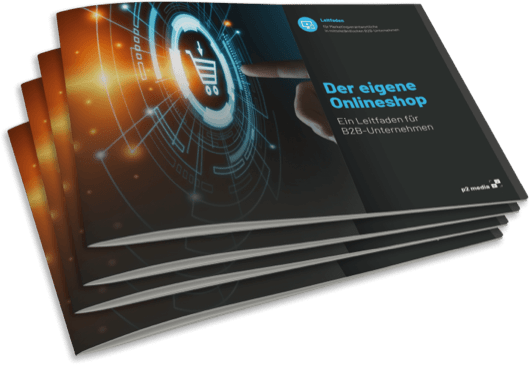Do you also know this? A jumble of data across the most diverse departments, interlinking of the specialist departments and a data infrastructure that is in no way up to these requirements. Yet every day, highly relevant new data is added that must be taken into account. Many organizations are struggling with the challenge of making collaboration, communication, and data sharing more productive.
Software systems such as Enterprise Resource Planning (ERP) and Product Information Management (PIM) enable companies to collect and distribute relevant information about different activities and their status from various departments.
PIM vs. ERP - Which system is the right one for me?
What is the difference between PIM and ERP? What are the benefits and advantages of each and when is such a system needed at all?
This knowledge gap often stands in the way of high growth and productivity. With this article, we want to remedy this and clear up any ambiguities.
PIM stands for
- a system that helps companies manage their product-related data for marketing and sales purposes in a way that consolidates appropriate, consistent, and complete product information in a structured manner.
- The collection of product specifications, product lifecycle information, technical specifications, digital assets, rich media, product metadata and information, from any internal or external source or department related to the company.
- The delivery of all collected information and data to every customer touch point.
The PIM platform enables companies to become increasingly consistent, compliant and efficient through a seamless flow of reliable product information from manufacturing through the supply chain to market and ultimately to the customer.
ERP is software used by companies to manage everyday business processes, such as human resources, accounting, compliance, sales, project management, supply chain operations, risk management, or customer relationship management.
An ERP system uses a common set of data definitions that operate on a single database and function on an integrated software platform.
Broadly speaking, an ERP system enables a seamless flow of data by linking various business processes. It brings together transactional data from multiple sources across an organization to provide the highest data integrity and a single source of truth, eliminating data duplication.
ERPs are used by companies of all sizes and industries to handle various processes.
PIM
- Data Management: The PIM solution promises superior product information by consolidating data through a single source to ensure high data quality, accuracy, consistency and completeness. This reliable product information is the foundation for all business trading efforts.
- Data integration: whether it's internal product information sources (e.g., applications, systems, or hard drives) or external sources (e.g., suppliers, mobile apps, online storefronts), integration remains intact.
- Adaptability: a modern product information management (PIM) system ensures that it is adaptable to your existing processes and also flexible to future needs, whether it is adapting to new catalogs or rapidly expanding into a new market.
- Automation: a PIM platform provides businesses with the function to automate labor-intensive and repetitive tasks and streamline processes. It helps in performing bulk activities, tracking tasks and validating the work. Automation helps your resources to focus on their core activities and come up with creative solutions.
ERP
- Cross-departmental collaboration: ERP ensures that business units and processes across the enterprise are connected for smooth execution. For example, when a new product is ordered, a credit check is automatically initiated, product availability is queried, and then the distribution schedule is updated. Finally, an invoice is sent after shipment.
- Real-time readiness: Well-integrated departments are facilitated to collaborate in real-time, saving a lot of time in initiating customer orders. Once an order is placed, things move quickly within departments, for which real-time readiness is crucial.
- Single database: A single database ensures common data definitions across the enterprise that every department in the company relies on. However, certain ERP systems separate the database to improve its performance.
- Tracking and Visibility: ERP software provides enterprise-wide visibility. Thus, ERP systems have various tools to track diverse data sets to keep track of important activities.
- Fast Time-to-Market: By eliminating manual and repetitive tasks across the enterprise ecosystem, PIM helps get products to market quickly and generate immediate revenue.
- Omnichannel commerce: By distributing consistent product data across diverse channels, companies can ensure purchase continuity across all customer touchpoints.
- Reduced costs: increased automation, bridging silos, and systems integration reduces the consumption of corporate resources and dramatically lowers the cost of performing complex IT tasks.
- Improved conversion: enhanced customer experience (CX), personalized selling, constant product availability promotes customer loyalty, which usually leads to increased average order value as well as high customer lifetime value.
- Reach new markets faster: By providing high-quality data in multiple languages, PIM enables companies to quickly launch products in different geographic locations.
PIM acts as a central hub for all product data originating from various sources such as CRM, ERP, WMS, data suppliers, internal systems and external agencies. Its task is to collect, consolidate, enrich and disseminate data. In doing so, PIM is connected to various output channels (mobile apps, websites, native apps, marketplaces, smart devices, etc.).
Atthe heart of an ERP system is a shared database that supports and connects multiple functions so that employees from different business units can access the same data. This shared data is used across departments in human resources, bill of materials, purchase orders, project management, invoicing, inventory management, quoting, asset management, employee training, etc. for their respective purposes.
PIM manages data such as product specifications, technical specifications, product lifecycle information, product metadata information, digital assets (including images, videos, animations, etc.) collected from almost all possible internal or external sources.
Information in ERP refers to a single, commonly defined schema (or data structure) that is stored in a common database and has a standard definition. The data may relate to product manufacturing, inventory, warehouse and distribution network, human resources (employees and hiring processes), corporate accounting, customer database and business performance analysis.
The scope of PIM includes centralization and synchronization of product information to serve as a unified and error-free source of information for the departments like marketing & sales, customer care, procurement, eCommerce managers, research & development, and moreover, suppliers. It also helps CIOs to improve efficiency and increase CX, thereby increasing overall revenue.
ERP, on the other hand, involves finding organization-wide constraints to improve connectivity between departments, increase productivity, reduce time, eliminate manual processes, keep an eye on operational effectiveness, and provide analytics as well as reporting.
The need for a PIM system arises when companies want to improve the following: Data Quality, Omnichannel Presence, Time-to-Market, Efficiency, Product Experience and ROI. PIM helps you by getting products to market quickly in global markets, providing better enterprise-level data governance, and leading you to high revenue growth.
The need for an ERP is when companies take too much time and resources to get business units to communicate with each other or you lose track of faulty processes in your business. These can be improved and automated with an ERP. Additionally, an ERP makes sense to gain transparent access to critical business metrics and effectively manage your legacy applications
Can PIM and ERP work together?
Absolutely! ERP and PIM systems can work together in perfect harmony.
ERP systems include a lot of information about various resources within a company, such as logistics, products, customers, inventory availability, location of warehouses, and prices. They are built to track the inventory of products and their movement within the company until they are sold.
Thus, an ERP has a very different view of products, that of marketing and sales, which is presented in a simple way. Marketing, on the other hand, is constantly looking for vivid product descriptions and images to make products appealing.
This is exactly the gap that PIM fills. A PIM system takes product data from an ERP system (and various other systems) and enriches it to make it suitable for marketing and sales.
ERP simplified! This is helped by the additional integration of PIM
- Introducing a new product line: The data of a new product line is usually imported into the ERP system. However, it may happen that the new product has a "new" product tag, a type of information that was previously not relevant to the existing ERP system, but which can be a great selling point. However, creating a new input field is not possible without the intervention of the ERP consultant, which can lead to significant delays.
- Updating product information: to continue the example above, there may be times when product information needs to be updated or changed, for example due to new legislation, certifications or government regulations.With an ERP system, updating every product in an entire product line can be time-consuming, resource-intensive, and even error-prone. If the company has a PIM, it is simply a matter of updating the information in the product field once, and that information is automatically propagated to all subsequent levels and sub-levels. This way, the company becomes compliant in no time, the information is automatically updated, and the error rate is eliminated.
- Preparing newly acquired products for sales: your newly acquired products need to be prepared for the market, even if their sales potential is not yet fully known. Now, creating space in the existing ERP by pushing aside your core products that are selling well may not be the right thing to do. However, if the company has a PIM solution, the new products can be entered immediately. The products can bypass the ERP (without disrupting its data) and reach marketers, who can test the waters by using the product data in an appealing way to sell.
- When rich product data is needed for marketing: since data stored in an ERP is transactional, it can be routed to output channels such as websites, mobile apps, etc. However, marketing often requires rich media content about the products, including images, videos, animations, and other multimedia files to make the product look as useful or attractive as possible. Since ERPs are not designed to carry such information, it is read manually from each system or from disk. When a PIM platform is used instead, every piece of information about the products is already consolidated in it.Therefore, marketers can instantly "publish" this information to multiple channels and languages to achieve their goals.
- Finding product data in ERP: There may be a small component, an accessory (say in a certain color and dimension) that is used in a product that is not receiving positive feedback. Finding such a component in an ERP system can be extremely difficult as it may not be there as a feature. This is because it may have been taken from an Excel file from one of the hard drives. In this case, finding such a component can be difficult. If a PIM system is in place, searching the consolidated repository of product data will turn up this component immediately.It can then be returned to the supplier for replacement or repair. Finally, the information can be quickly shared across all output channels.
The symbiosis of PIM and ERP offers the following advantages
Since both PIM and ERP have their unique potential, each only strengthens the other with its presence. A PIM-ERP integration takes care of the key critical back-end functions as well as sales related to front-end eCommerce.
Some of the obvious benefits of integration are:
- Superior inventory management: ERPs give companies an overview of all inventory and help manage products by stock and orders. In contrast, PIM compiles product taxonomies, categorizes them by attributes, and creates relationships between them for optimal marketing and content distribution. Roughly speaking, while ERP updates inventory information, the PIM platform ensures that enriched, accurate product data is displayed on multiple channels.
- Quickly send data to partners: partners such as distributors or retailers need not only clearly articulated critical data about products, but also marketing data, as they are also involved in the sales process. Typically, all partners require companies to fill out item configuration sheets for them. Since an item configuration sheet is a channel-specific specification sheet for product data, it requires data from ERP and PIM such as GTINs (Global Trade Item Number), UPC (Universal Product Code), specifications, attributes, and other product content that partners need for successful selling.
- Effective marketing/precise pricing: ERP manages product pricing of all types, including wholesale price, minimum advertised price (MAP), role-based price, and category-based price. Selling through different channels may require different pricing on products for different recipients. In addition, they may change from day to day (depending on offers, promotions, and schemes). ERPs can efficiently provide important pricing information to all departments, but they may not pay special attention to marketing/sales. However, when product information is fed from an ERP into the PIM, a sales-specific database is created.
- Faster setup and enrichment of variants: when setup is done in an ERP and additional attributes such as images, animations, marketing content are added via PIM software in a variant-specific manner and then populated into digital catalogs and pages, it provides a delightful experience to the customer. Therefore, PIM-ERP integration paves the way for retail success.
- Improved overall merchandising: since ERPs monitor all sales, accounting, and order information, it has a bird's eye view of the data. It can analyze products, predict sales, identify which product needs to be liquidated, and change sales strategies because PIM does not have visibility into sales numbers (once products are sold). ERPs, however, can forecast sales based on reliable insights and metrics and pass them on to marketing, which can then formulate a marketing strategy. Therefore, the combination of ERP and PIM system can be used to create a solid, informed merchandising plan.
FAZIT
What this article clearly shows is that a PIM system significantly facilitates the daily work of marketing and sales by processing and utilizing mainly product-related marketing data.
The ERP, on the other hand, refers to the everyday business processes and also takes a very important position in the optimization of these.
Nevertheless, the systems are not mutually exclusive. On the contrary: they build on each other and enrich the company with a good basis for the efficient control of processes.
We are happy to support you in the decision-making process and introduction of a PIM (Product Information Management) system:
- Requirements workshop on the topic of product data - in the workshop we jointly develop the class model for maintaining the product information and set up the object classes together with you.
- Setup and installation of the PIM incl. required software components in a specialized hosting environment.
- Provision of a universal interface with which the import (MXL, CSV, JSON, Excel, etc.) of your existing product data into the PIM system can take place. The API also allows you to export feeds and create Rest APIs into any application.
- Connection of the PIM system to your required output systems (website, eCommerce shop, app, Adobe InDesign, etc.) as well as creation of the required templates
- Editorial training on the use of PIMCORE
You will find further interesting topics related to PIM here:
Oliver Parrizas will be happy to answer any questions you may have on the subject. +49-800-911-91-91













